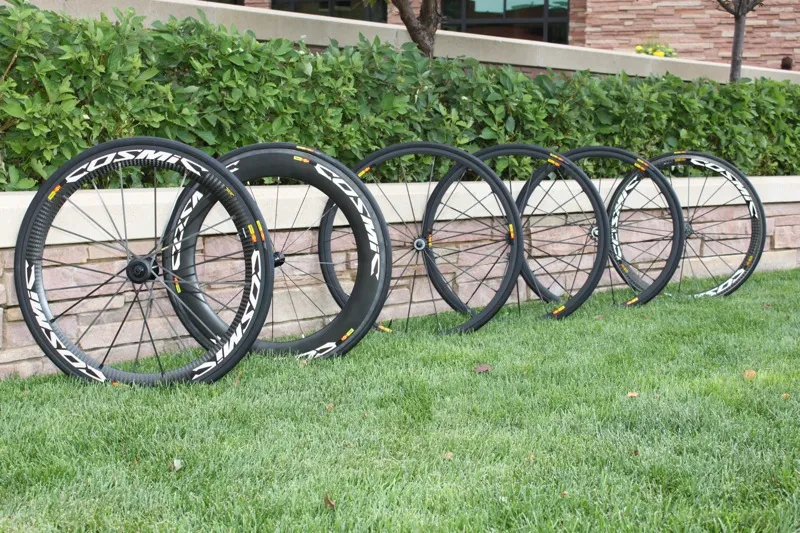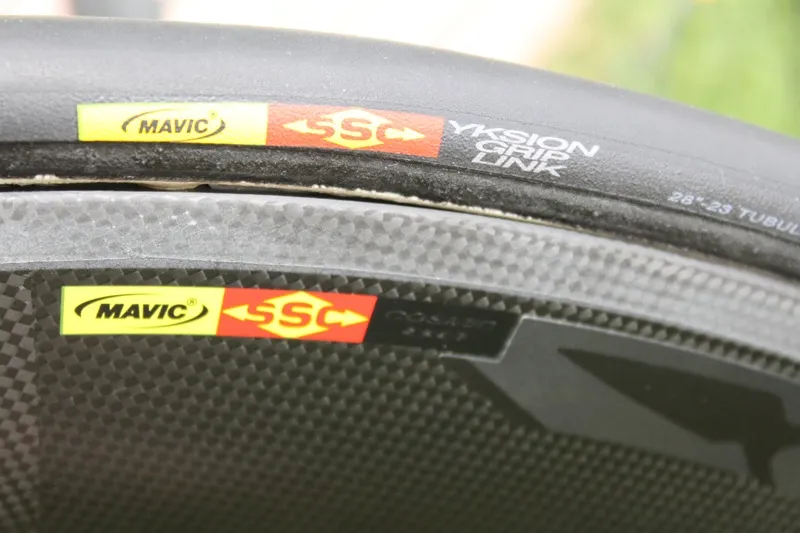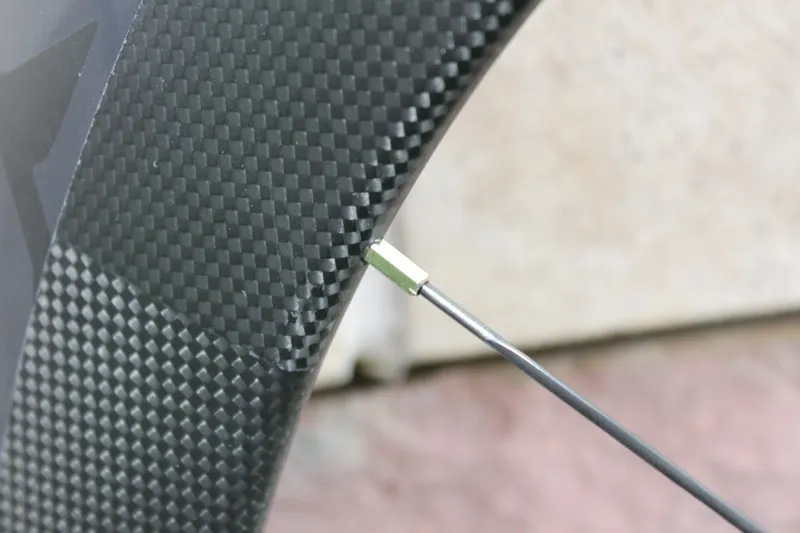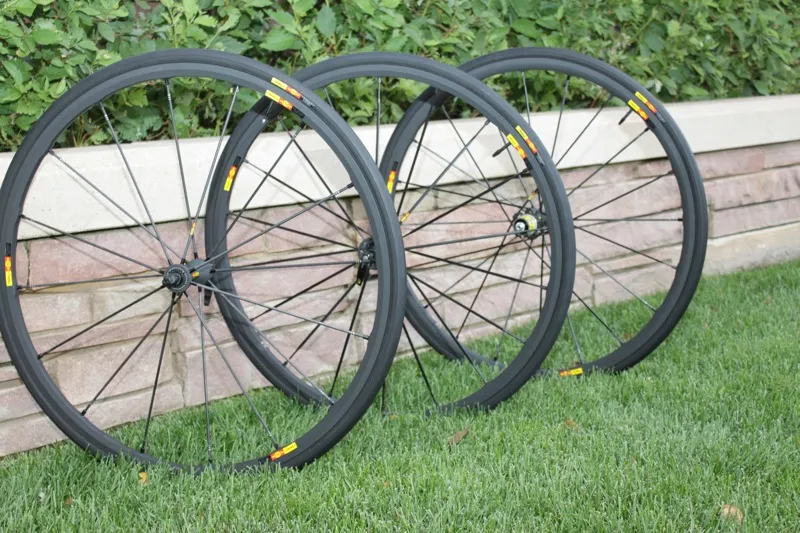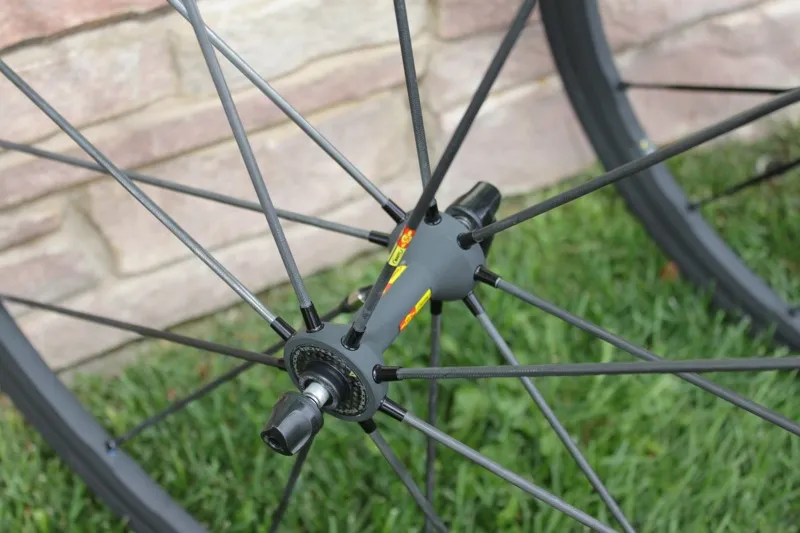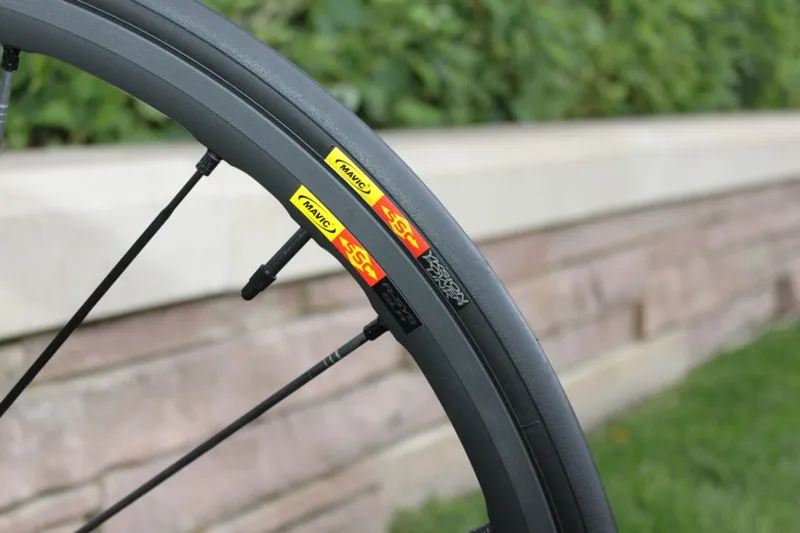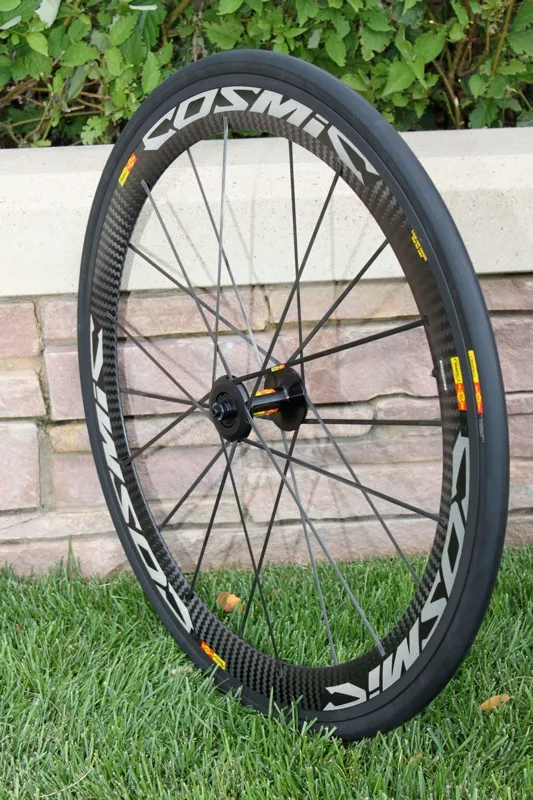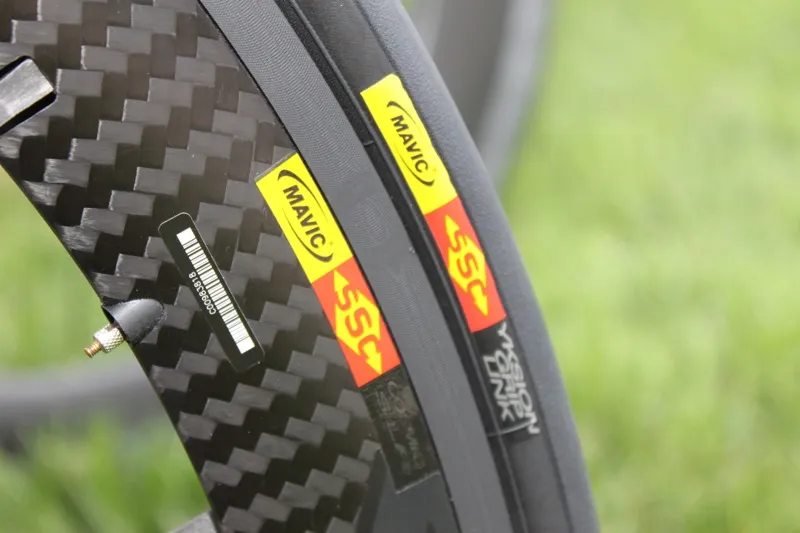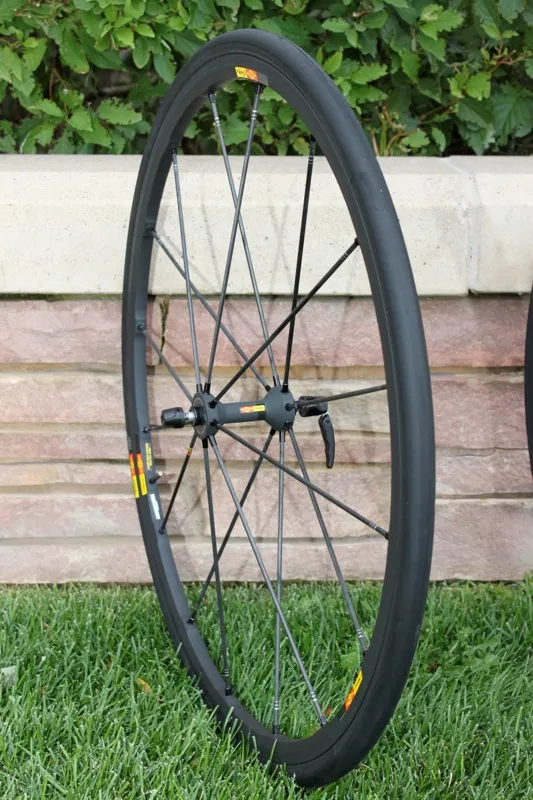Mavic have been wheel sponsors of the Garmin-Transitions ProTour team since the start of the year and the first fruits of that partnership are now emerging, in the form of several new products for 2011.
In particular, the American squad are helping to drive the development of the company's new complete wheel systems, including Mavic-designed tyres. The highlights are the new Cosmic Carbone 80 wheels, paired with GripLink and PowerLink tyres and a new braking suface called Exalith.
"People using the stuff have great opinions but often don’t have a great conduit to get that information back to the manufacturer," said Will Frischkorn, sponsor liaison (and former rider) for the Garmin-Transitions team.
“I take the feedback from our 28 guys and try to condense it into a usable nugget. With Mavic it’s been a real co-ordinated effort, which is fun because we’re having a real impact on things.”
Exalith rim coating
For 2011, Mavic’s biggest technological breakthrough is their new Exalith coating for alloy rims. This treatment is akin to anodisation yet penetrates the rim much deeper – up to 10 microns – and is much harder.
Mavic say Exalith rims have virtually no wear in their brake tracks and have double the lifecycle of standard rims when it comes to micro cracks around the spoke eyelets. The hardness of the coating also allows Mavic to machine roughly 10g more material off each rim, further reducing their inertia.

Besides the Exalith coating, the rims feature an aggressive machining to aid in bumping up the braking performance
All of Mavic’s Exalith products are manufactured and assembled in France so they can carefully control the process and keep it a proprietary technology. While the strength and wear resistance the coating provides is impressive, there are two other features that riders will gain more immediate appreciation for.
Firstly, Exalith rims provide a drastic increase in braking friction. This is due to the hardness of the material, aggressive machining and added Exalith coating deposited on the brake track.
This means the rims require special pads (a set is supplied with them) – a standard pad would shred in one descent – but offer a tangible performance benefit compared to any other carbon or alloy rim on the market.
The second immediate gratification is the unique, subtle look of the matt grey rim and accompanying hubs. Yes this is a superficial benefit that’s subject to taste, but it definitely struck our fancy.
BikeRadar had the chance to take a short ride on two pre-production Exalith wheelsets, Cosmic Carbone SLR and Ksyrium SLR, and found that the coating definitely seems to provide a dramatic increase in braking power. However, we have to reserve our final opinion until a proper test of production samples can be carried out.
Wheel and tyre system
If Exalith is Mavic's biggest technological breakthrough for 2011, the expansion of their wheel and tyre system development is the biggest design breakthrough. While the benefits of designing wheels and tyres together are harder to immediately quantify – without a wind tunnel – their impact, especially to a team like Garmin-Transitions, will be just as great.
“The biggest reason for doing this is to create new technologies,” said Sean Sullivan, Mavic’s North American marketing director. “We want to make a system that performs better than the sum of its parts.”
Mavic’s principal example of this for 2011 is the Cosmic Carbone 80 paired with the GripLink front tyre. They claim this combination to be faster than anything comparable on the market, and cite wind tunnel data from testing in Magny-Cours, France, as well as sessions with Garmin at the Mercedes Petronas F1 wind tunnel in Brackley, UK.
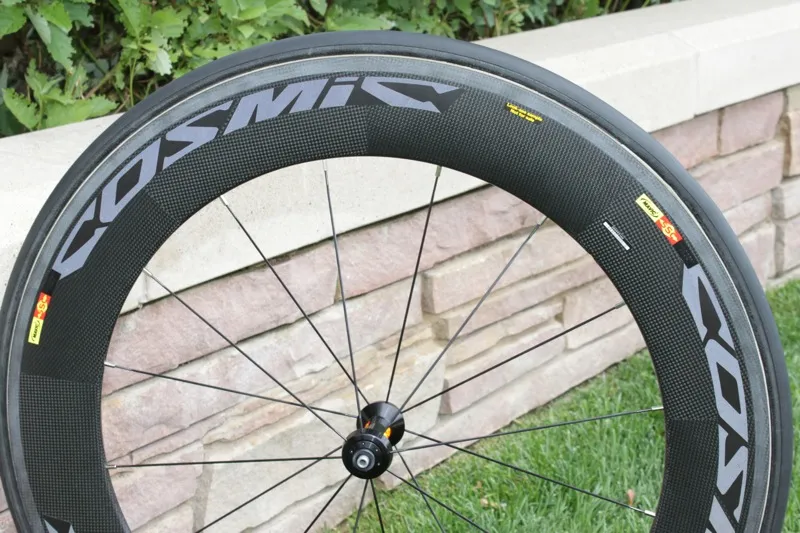
Key to the CC80s' performance is matching the rim with the tyre to maximise aerodynamics
Mavic are adding two new models of Yksion tyres to their range for 2011, which are front or rear specific and available in clincher and tubular styles. The Yksion PowerLink is Mavic’s rear tyre, which pairs a 70a durometer centre tread with 60a sides. The front tyre is called Yksion GripLink and is also dual compound, but it uses a 60a centre tread that’s complemented with a 60a S side, which has added silica to enhance grip.
The tubular version is made with a 290tpi casing, while the clincher version is 127tpi to save weight (higher thread counts equal more weight and expense). Both feature smooth treads and are only available in a 23mm width. While Mavic will sell the tyres in packages with their wheels, replacements will cost £65/US$99 for tubulars and £39/$59 for clinchers.
Mavic will continue to offer their original clincher tyre, which was launched last year – the Yksion K10, a 23mm, 290tpi open tubular tyre. All of Mavic’s tyres are made by Lion Tyre, Vittoria’s Thai-based manufacturing arm. We rode both the Yksion GripLink and PowerLink clinchers and tubulars, and our initial impression was good, with the front tyre in particular having a very grippy feel.
Wheel system breakdown
Mavic’s 2011 press launch focused on their Special Service Course (SSC) range, all of which will only be sold as wheel and tyre systems in 2011. These wheel systems represent their top-tier and latest technologies, which we’ve touched on above.
Garmin-Transitions’ go-to wheels
The Cosmic Carbone 80 (CC80) is Mavic’s newest wheelset, which was first seen under Garmin-Transitions at the Tour of Qatar. It’s a speed wheelset for fast flat stages and time trialing. The Asian-made 80mm tubular (only) rim is designed to aerodynamically match the GripLink and PowerLink 23mm tyres. It was developed in response to Garmin's need for a time trial wheel made to fit a larger tyre.
According to Mavic, the CC80 is as fast as the track-intended i0, when both are equipped with 23mm tyres (the i0 is built to be best aerodynamically with a 19mm tyre). Plus, Frischkorn says it’s infinitely more manageable and aerodynamic in crosswinds due to its use of 16 front and 20 rear bladed, stainless 14 gauge spokes with external nipples. Claimed weight of the pair is 2,330g with tyres or 1,750g without. The CC80 wheelset will cost £1,800/$2,700.
Mavic claim that even when shod with a third party tyre (Vittoria), the CC80 boasts better aero numbers than any of the competition, and this gap increases when using Mavic's own rubber. The company say that developing the tyre and wheel together has more of an impact than anything done to modify the aero properties of a rim.
Garmin’s everyday race wheel is Mavic’s stalwart Cosmic Carbon Ultimate (CCU). While the wheel itself doesn’t change for 2011, it will now be offered as a system with Mavic’s tubular tyres. The CCU is exclusively made in Mavic’s French facilities. The set weighs 1,765g with tyres and costs £2,500/$3,600.
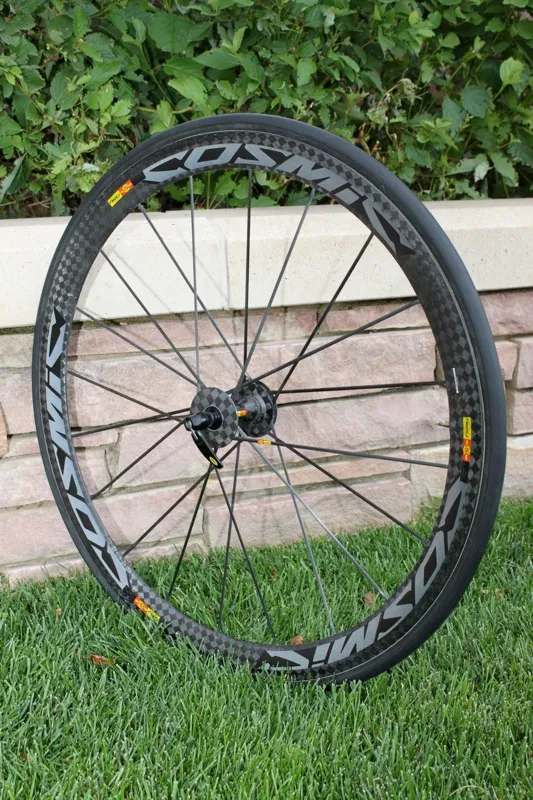
Mavic's go-to ProTour race wheel, the Cosmic Carbone Ultimate
Mavic’s testing claims the 40mm-tall CCU (1,200g actual) is almost as light as a Zipp 202, yet 37 seconds faster than a Zipp 404 over the course of a 40km time trial (steady state 50kph, 0 degree yaw) while being over 40 percent stiffer than the 404, laterally.
Mavic’s Comete Road rear time trial disc, which differs from the track version, is also updated for 2011 with the Exalith alloy coating on its brake track and rim. The wheel is sold with a tyre, but without a front wheel. The wheel/tyre package weighs 1,440g and costs £1,900/$2,900.
Developed for you, used by the pros
Mavic are the first to admit that their R-SYS wheel was developed for sportive and gran fondo riders, not the pros, but that hasn’t kept the wheel out of competition. According to Frischkorn, many of the Garmin riders like the ride feel of the R-SYS and use the set on big mountain days or pair it with a rear CCU for rolling days.
Frischkorn also said that, in the team’s wind tunnel testing, the way the wheel interacts with a Felt fork (the team all ride Felt bikes) makes it more aerodynamic than a Zipp 303. “It was a surprise for all of us,” said Frischkorn. “The front wheel acts as sort of a trip to smooth air over the fork [making the overall system more aero].”
Given the R-SYS’s spotted history we asked, once again, for reassurance regarding the safety of the wheel. Mavic reiterated that the spokes have been redesigned with multi-directional fibre and more of it – the original R-SYS spokes were unidirectional – and are pinned at their ends. These are all features that came after the first recall.
Mavic say that in their testing, where a steel bar is jammed into the spokes while the wheel is spinning, the R-SYS performs better than a traditional steel spoked wheel or one built with their Zircal alloy spokes.
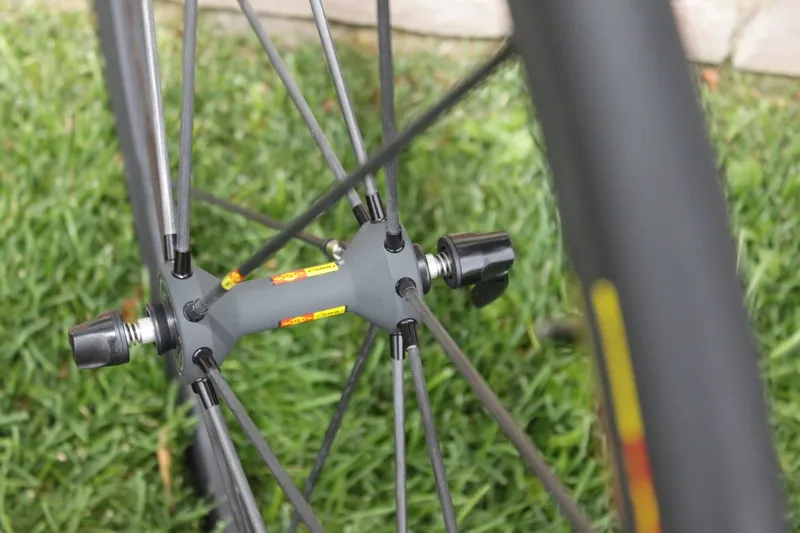
The R-Sys SLR front wheel is said to be roughly 30 percent stiffer than the Ksyrium equivalent
The 2011 R-SYS SLR features the new Exalith rims front and rear, and is available in tubular or clincher versions. The clincher system has a claimed weight of 1,994g (the wheels alone weigh 1,370g) and costs £1,330/$2,000. The tubular version weighs 1,955g and costs £1,382/$2,080 with tyres. All R-SYS wheels are made in France, regardless of whether or not an Exalith rim is employed.
If you’re still hung up on the R-SYS’s spotted history, the new 2011 Ksyrium SLR wheel system may still be an option. The set pairs a Zircal-spoked Ksyrium style front wheel with the R-SYS Tracomp rear wheel. The set uses the same Exalith rim with the same spoke count – providing all of the braking and strength advantages – as the R-SYS SLR set, but built with a Ksyrium hub and alloy spokes. The different spokes only add 30g to the wheelset’s overall weight, yet the changes shave £130 from the system price, which totals to £1,200/$1,800 for clinchers or £1,252/$1,880 for tubs.

The Ksyrium SLR front wheel saves £130 over the R-Sys model, yet only adds 30g
Finally, Mavic’s clincher-only Cosmic Carbone SLR comes with an Exalith rim for 2011. The wheelset uses the R2R (rim to rim) continuous carbon fibre spokes borrowed from the CCU paired to a 52mm Cosmic Carbone clincher rim. The Exalith rim drops 20g from the wheelset’s 2010 weight and improves its wear, strength and braking properties. It costs £1,700/$2,450. Although Mavic produce a tubular version of this wheelset for Garmin and other sponsored teams, they don't see enough demand to offer it commercially.
Full steam ahead
Last year, it was hard to get too excited about the K10 wheelset, which served as Mavic’s introduction to wheel and tyre systems – it was simply a Ksyrium Premium wheelset with a pair of Mavic branded tyres. The 2011 line, however, represents real progress for the French company.
Exalith and the wheel and tyre system concept, which of course is not unique to Mavic, show progress by the brand’s product development team and a unique reward for their sponsorship of the Garmin-Transitions team. The latter system development will continue, with the team using both Mavic wheels and tyres in 2011.
“We're at the starting point of our development of thinking about the overall system of wheels and tyres,” said Francois Xavier Blanc, Mavic's international marketing director. “Here you can see that it makes complete sense in terms of aerodynamics because you know the exact design and profile of the tyre and then you can fit it perfectly to the rim. This opens new doors for us. It’s what we call the wheel tyre system approach and it’s the future of Mavic and the future of wheel building.”
